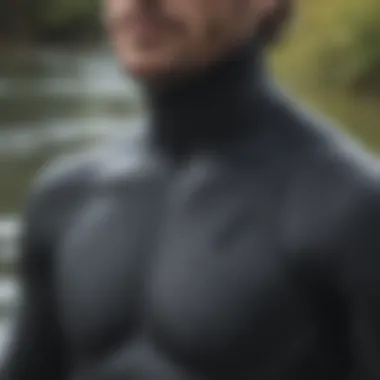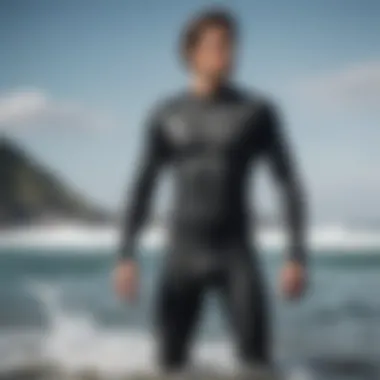Essential Guide to 60 Degree Water Wetsuits for Kiteboarding


Intro
In the world of kiteboarding, the right wetsuit can make all the difference between a great day on the water and a memorable fiasco. As the temperature of the water dips to around 60 degrees Fahrenheit, the importance of choosing a suitable wetsuit becomes paramount. Not only can a well-fitted wetsuit keep you warm, but it also enhances your performance and provides a layer of protection against potential injuries.
With diverse materials available and several styles to choose from, selecting the right wetsuit might feel as complex as trying to understand a riddle wrapped in a mystery. This guide aims to walk you through the essentials of wetsuit selection for kiteboarding, focusing on both functionality and comfort.
By the end of this article, you'll gain insights into the various features that contribute to a wetsuit’s effectiveness, tips on choosing the right one based on your personal preferences, and some maintenance hacks to ensure it lasts through many seasons of riding the waves. Let’s dive in!
Understanding Water Temperature and Its Challenges
When it comes to kiteboarding, the water temperature can really make or break your experience. Understanding how 60-degree water affects your performance and comfort is crucial, especially for those who might not be used to braving the chill. In this segment, we'll dive into the ins and outs of kiteboarding in cooler waters and spotlight the factors that come into play.
The Impact of Degree Water on Performance
The temperature of the water has significant effects on both physical and psychological performance. 60-degree water can feel brisk, and that can influence your stamina out on the water. Some kiteboarders may find they tire out quicker than in warmer waters, as their bodies expend extra energy trying to maintain core temperature.
In practical terms, this means you might need to adjust your riding style when the waters get cool. Your reflexes may not be as sharp as when you're comfortable. As an example, a common scenario can happen during a jump. If the water is cold, you may hesitate or undervalue your jumps due to the discomfort. It’s essential to stay calm and remember that your skills remain intact, even if the cold can feel a bit daunting. The body might tighten up a bit; that's where a well-fitting wetsuit comes in handy to keep your muscles loose and responsive.
Physical Responses to Cold Water
The body reacts to cold water in several ways. Initially, exposure can cause a sudden gasp reflex. It’s a natural reaction when quickly plunging into cool temperatures. After that, there's vasoconstriction, where blood vessels tighten up, limiting blood flow to the periphery, prioritizing vital organs instead. This can lead to hands and feet feeling a touch numb, which can hinder grip and control over your equipment.
Moreover, prolonged exposure may lead to decreased coordination and slower reaction time, making it vital to listen to your body. Just because you’re a seasoned kiteboarder doesn’t mean you are impervious to the effects of cold water.
To combat these challenges, here are a few adaptive strategies:
- Awareness of body signals: Understanding when to call it a day is key, particularly in cold water.
- Stay suitably dressed: Choose wetsuits designed specifically for cold water conditions. They should fit well to maintain body heat without causing fatigue from constriction.
- Pre-activity routines: Engaging in a good warm-up routine can help get the blood flowing before you hit the waves.
"Preparation is key. A well-planned session can make all the difference between enjoyable time on the water or shivering in your boots."
Scotties thrive in cooler climates, and kiteboarders can, too, with the right understanding. Carefully navigating the challenges presented by water temperature is just as important as mastering your tricks. Stay tuned as we delve into the essential role of wetsuits in kiteboarding.
The Essential Role of Wetsuits in Kiteboarding
In the world of kiteboarding, where wind and water splash together in a symphony of thrill and exhilaration, a wetsuit serves more than just a second skin. It's an essential tool that can not only elevate performance but also safeguard the health of the rider. As one dives into waters at 60 degrees Fahrenheit, the chill can seep into bones quicker than a wink, making the right wetsuit a non-negotiable piece of equipment. Understanding its role helps kiteboarders appreciate the art of staying warm while navigating the waves, thus transforming a potentially miserable experience into one of enjoyment.
How Wetsuits Provide Insulation
Wetsuits are designed primarily to offer insulation, shielding the body from cold water temperatures. They trap a thin layer of water between the suit and the skin, which warms up due to body heat. Although it may sound like a paradox, staying wet actually works in the wearer’s favor—when equipped with the right suit.
This insulation is especially crucial in chilly waters like those at 60 degrees, where prolonged exposure may lead to numbness or loss of dexterity. A well-fitted wetsuit should hug the body firmly, minimizing water exchange and allowing for optimal insulation. Furthermore, innovations in materials, such as neoprene thickness, work towards enhancing warmth without adding bulk.
- Thickness Matters: Generally, a 4/3 mm wetsuit is well-suited for kiteboarding in 60-degree water, providing the perfect balance of flexibility and warmth.
- Sealed Seams: Opting for sealed seams prevents water from sneaking in and helps maintain core temperature.
A deeper dive into the fabric technology might reveal that certain suits incorporate thermal linings or even hollow fibers, further optimizing heat retention. It's akin to having a cozy blanket wrapped around you while you glide through the water, allowing for extended sessions without succumbing to cold weariness.
Wetsuits and Buoyancy
Another vital aspect of wetsuits is their buoyancy. While most kiteboarders may not think of buoyancy as an issue, having a suit that allows for better flotation can be crucial, especially in challenging conditions. Wetsuits are inherently buoyant due to the materials they are made from, granting an extra lift that can assist in staying afloat.
The buoyancy aspect not only helps when tumbled from the board but also encourages a more relaxed state while cruising. The stress of sinking is mitigated, enabling clearer thinking and more control over movements.
- Enhanced Safety: In unpredictable water conditions, the buoyancy provided by wetsuits can deliver that added peace of mind, which is something kiteboarders should not overlook.
- Weight Distribution: The buoyancy balances the weight of the rider and gear, aiding in smoother transitions and jumps over the waves.
When kiteboarders paddle out into 60-degree water, a wetsuit's buoyant properties can enhance performance. All these considerations encourage choosing a wetsuit not just for style but for practical considerations that affect comfort and overall experience on the water.
A perfect wetsuit isn’t just a piece of clothing; it’s a trusted companion in the ever-changing dance between rider, wind, and water.
Ultimately, acknowledging the essential role wetsuits play can elevate not just performance but also the overall enjoyment of kiteboarding in chilling waters.
Types of Wetsuits Suitable for Degree Water


When it comes to kiteboarding in chilly 60-degree waters, choosing the right wetsuit is crucial. The type of wetsuit you select can make a world of difference in comfort, flexibility, and overall performance on the water. Understanding the nuances between different wetsuit styles helps kiteboarders make informed decisions that can significantly enhance their experience. A well-chosen wetsuit not only protects against cold temperatures but also assists in buoyancy and mobility, making it easier to maneuver on the water.
Full Wetsuits vs. Short Wetsuits
Navigating between full wetsuits and short wetsuits is like choosing between an umbrella and a rain jacket—both have their merits, depending on the conditions. Full wetsuits typically cover the entire body, providing extensive insulation. They come in various thicknesses, usually ranging from 2mm to 5mm, and are designed for colder temperatures like 60 degrees Fahrenheit. Short wetsuits, or spring suits, have shorter sleeves and legs, which offer less warmth but can be beneficial in warmer conditions or for those who prefer a freer range of motion.
A full wetsuit is perfect for when the cold bites, wrapping the body in a cocoon of neoprene that retains body heat. However, if the sun is shining and the wind isn't too fierce, a short wetsuit may be all you need to stay comfortable. This choice often comes down to personal preference and how sensitive one is to the cold.
"The right type of wetsuit can turn a good day on the water into a great one. It pays to know your options!"
Thickness and Neoprene Variations
Thickness plays a pivotal role in how well a wetsuit performs in cooler waters. For 60-degree water, wetsuits often range from 3mm to 5mm in thickness. Thicker wetsuits provide more insulation but can be bulkier and stiffer, possibly hampering movement. Conversely, thinner wetsuits allow for greater flex but at the cost of warmth. Many kiteboarders compromise with a mid-range thickness, often around 4mm, allowing for adequate warmth while maintaining the agility needed for tricks and maneuvers.
Neoprene compounds have evolved in recent years, leading to various types of neoprene used in wetsuit manufacturing. Look for features like:
- Super-stretch neoprene: Offers maximum flexibility, vital for kiteboarding actions.
- Smoothskin or GlideSkin: Reduces water entry and increases warmth.
- Eco-friendly materials: Many brands are now offering wetsuits made from recycled materials, making a more sustainable choice.
In sum, when selecting a wetsuit, consider both thickness and neoprene variations. Understanding these factors leads to an optimal balance of warmth and flexibility tailored to individual kiteboarding needs.
Selecting the Right Wetsuit for Kiteboarding
Choosing the right wetsuit for kiteboarding is not merely a matter of personal preference; it directly impacts your comfort, performance, and safety while out on the water. Kiteboarding in 60-degree water presents unique challenges that require thoughtfulness in your gear selection. With varying opties available on the market, knowing what to look for can make all the difference between a smooth ride and a chilly experience.
Fitting and Comfort Considerations
When it comes to wetsuits, fit truly is king. An optimal fit means that your wetsuit should snugly hug your body without being overly restrictive. If you’ve ever been in the water with a suit that’s too loose, you know it can feel like you’re swimming with bricks tied to your ankles. Achieving the perfect fit can be summed up in a few points:
- Chest and Torso: Your suit should fit tightly across your chest and torso, with room for movement in your shoulders. Any excess space here allows water to seep in and decreases insulation, cooling you down faster than a pop can on a summer pavement.
- Arms and Legs: Sleeves should reach just short of your wrists, and legs should end just above your ankles. Excess fabric can cause chafing and inconsistent water flow around your body, which might dampen your performance.
- Neck and Seals: A snug collar helps prevent cold water from spilling in. It shouldn’t be so tight that you can’t breathe, though! Look for suits with adjustable collars to find the balance.
Finding comfort is also crucial. Wetsuits come in different thicknesses, mainly influenced by the specific water temperature and activity level. A thickness of 4-5 mm is typically ideal for 60-degree water. Remember: If you’re not comfortable, you’ll struggle to concentrate on your riding.
Features to Look For
Various features can enhance your kiteboarding experience, especially when you’re tackling colder waters. Here are key aspects to keep an eye out for:
- Neoprene Material: High-stretch neoprene materials allow for greater flexibility while still providing warmth. Look for super-stretch or thermal linings that can trap heat without hindering your movement.
- Seams: Pay attention to the construction of the seams. Flatlock seams are great for warmer weathers as they allow water to escape, but when it's chilly like in 60-degree water, you want glued and blind-stitched seams. These seams provide a more watertight seal, keeping those cold temps at bay.
- Zipper Design: Many wetsuits come with back zippers, while some offer chest zippers as well. Chest zippers usually provide a better seal against water entering, enhancing overall insulation. Just remember that ease of entry matters. You don’t want to be wrestling with your gear before you hit the waves.
- Additional Features: Extra features like knee pads, reinforced areas, and drainage holes can improve overall durability and comfort. Consider your riding style and how rough you might be on your gear during maneuvers.
Maintenance and Care for Your Wetsuit
Taking care of your wetsuit is akin to giving your kiteboard a regular tune-up. It boosts longevity and ensures your comfort during thrilling rides in 60-degree waters. A well-maintained wetsuit not only performs better but also keeps you safe, offering the insulation and protection that's so vital in cooler conditions. When you invest in a good wetsuit, treating it right can make all the difference in your overall experience and performance on the water.
Cleaning Techniques and Best Practices
A clean wetsuit is a happy wetsuit. After each session, you should rinse it thoroughly in freshwater to get rid of salt, sand, and any other pesky debris that might’ve clung to it. Salt can wear down the materials over time, so don’t take this step lightly.
- Rinse: Use a hose with a gentle spray. Avoid high pressure, which might damage seams.
- Soak: If your wetsuit seems particularly dirty or has a funky smell, fill your bathtub with cool water and add a mild wetsuit cleaner. Soak for about 15 minutes.
- Gently Scrub: Use a soft sponge. For areas with more stubborn dirt, a soft brush works fine, but be gentle to prevent damage.
- Rinse Again: Make sure to rinse it again with freshwater thoroughly. This is crucial; no soap residue should be left.
- Dry: Hang it up to dry inside out in a cool, shaded area. Avoid direct sunlight, as it can break down neoprene over time.
Keeping your wetsuit clean helps maintain its functionality and keeps you comfortable for longer.
Storage and Longevity Tips
Proper storage is just as crucial as cleaning. If you toss your wetsuit into a heap or hang it in direct sunlight, you might be inviting trouble. Follow these tips to keep your wetsuit in the best shape:
- Use a Wetsuit Hanger: Thick hangers help maintain the suit’s shape. Avoid standard hangers that could stretch the shoulders out.
- Store Indoors: Keep your wetsuit in a cool, dry place away from sunlight. Basements or closets work well, just ensure good air circulation.
- Avoid Folding: Lay your wetsuit flat if you can, rather than folding it. Folding can crease the neoprene, weakening its structure over time.
- Inspect Periodically: Check for any signs of wear and tear, like small cuts or loose seams. Catching issues early can save you a headache later.
By following these maintenance and care guidelines, you're setting yourself up for success on the water, ensuring that your wetsuit will perform optimally when you need it most.
Safety Considerations When Using Wetsuits
When it comes to engaging in kiteboarding, particularly in the cool embrace of 60-degree water, the importance of safety cannot be overlooked. For enthusiasts and event organizers alike, being aware of the hazards that come with cold water exposure, as well as the role of proper gear, is paramount to ensuring a fun and safe experience on the water. This section delves into hypothermia risks as well as the importance of employing suitable wetsuit gear.
Hypothermia Risks in Cold Water


Cold water can be a sneaky adversary. Even if you're slicing through the waves with the wind at your back, the chilly temperatures can lead to hypothermia quicker than you think. It’s not just about feeling cold. Hypothermia occurs when your body loses heat faster than it can produce it, and in low temperatures, this process accelerates significantly. In 60-degree water, symptoms can spring up after relatively brief exposure, sending chills down your spine—literally.
How do you recognize hypothermia? Well, there are key signs to watch for:
- Shivering: It starts as a mild tremor but can escalate.
- Confusion: Your mind might start to feel foggy.
- Lethargy: Getting out of the water may suddenly feel like climbing a mountain.
- Loss of Coordination: It becomes hard to hold the kite or balance.
The best guard against these risks is preparation. Always monitor the time you spend in the water, and don’t hesitate to use a buddy system to ensure everyone stays safe. The right wetsuit acts as a barrier to the cold, but even the best gear has limits.
Importance of Proper Gear
Having the correct gear tailored for kiteboarding in 60-degree waters is non-negotiable. A wetsuit isn’t just a piece of clothing—it's your lifeline in chilly conditions. The right wetsuit offers insulation, buoyancy, and can even help prevent injuries while you navigate the choppy waters.
Here are some essential considerations for choosing proper gear:
- Fit: It’s crucial to find a wetsuit that fits like a glove. If it’s too loose, water will rush in. If it’s too tight, it can restrict blood flow and hinder your performance.
- Thickness: A wetsuit with the right thickness for 60-degree temperatures can make all the difference. Generally, a 3/2mm wetsuit is advisable for this water temperature, providing warmth without sacrificing flexibility.
- Sealed Seams: Look for wetsuits with sealed seams to help keep cold water at bay. This prevents water from sneaking in, enhancing thermal retention.
- Accessories: Don’t forget essentials like neoprene booties and gloves, which can further help ensure you stay warm and comfortable.
"Choosing the right wetsuit is like choosing a superhero cape—without it, you're just another person in the water, but with it, you're prepared for the battles that lie ahead."
Ultimately, your preparation and choice of gear can help you stay safe and prolong your kiteboarding adventures in colder waters. Pay attention to the signs of hypothermia, invest in proper wetsuit gear, and you’ll be much better equipped to enjoy every second on the water.
Environmental Impact of Wetsuit Materials
In recent years, the kitesurfing community has grown increasingly aware of the materials used in wetsuit manufacturing. With the environmental shift becoming hard to ignore, kiteboarders and enthusiasts face pressing questions about the impact of their gear on nature. Understanding the materials involved in the making of wetsuits is essential, not just for individual health benefits but also for the wellbeing of our oceans. The importance of this topic cannot be overstated as it brings awareness to sustainable practices and encourages informed buying decisions.
Sustainable Options in Wetsuit Manufacturing
Sustainable wetsuits are becoming more prevalent as companies acknowledge their role in environmental preservation. This part of the kiteboarding market has seen significant advancements, particularly with the introduction of eco-friendly materials. Brands now explore options like limestone-based neoprene, which is derived from renewable sources instead of petroleum. This shift is crucial because traditional neoprene production is highly carbon-intensive and harmful to marine ecosystems.
Additionally, a number of companies are innovating with plant-based alternatives, such as Yulex, which claims to offer a sustainable solution leveraging guayule, a type of shrub. Kiteboarders can often find that these wetsuits perform on par with, or even better than, conventional options while reducing one's carbon footprint without skimping on the necessary insulation and protection. Opting for sustainable materials not only benefits your body but also aligns your hobbies with a more responsible lifestyle.
Some benefits of choosing sustainable wetsuit options include:
- Reduced Carbon Emissions: Eco-friendly options often come with a significantly lower environmental impact.
- Less Harmful Manufacturing Processes: Many brands are adopting water-based adhesives and natural resources which minimize pollution.
- Incentives for Innovations: Consumer demand for sustainable products pushes companies to invest in research and development.
Disposal and Recycling of Old Wetsuits
As kiteboarders, we may focus heavily on what happens out on the water, but the life cycle of wetsuits doesn’t end when they are retired from active duty. The disposal of old wetsuits presents a considerable challenge that often gets overlooked. For starters, most traditional wetsuits are not biodegradable, so tossing them in the trash usually leads to them spending decades in a landfill.
Some proactive brands have set up reclamation programs for their suits, allowing customers to send back their old wetsuits for recycling. This approach not only minimizes waste but also promotes the circular economy. Recycled materials may be transformed into new wetsuits or other products such as accessories or even furniture. Adopting such practices benefits everyone - helps lessen pollution and provides opportunities for responsible ownership.
"Choosing a wetsuit is not just a personal choice; it's an environmental responsibility. Every small decision counts."
To further enhance eco-responsibility, kiteboarders may consider the following:
- Repair Over Replace: Small damages can often be fixed with patches or glue rather than considering a complete new wetsuit.
- Donation: If your wetsuit is still functional but no longer suits your needs, consider donating it to local charities or community programs.
- Awareness: Research brands that take sustainability seriously. Consumer power is significant.
By understanding the environmental impact of wetsuit materials and opting for sustainable choices, kiteboarders can fully enjoy their time on the water while ensuring they do not leave behind a trail of destruction on the environmental fabric. It’s all about making those waves without causing bigger ripples.
Comparing Wetsuits From Leading Brands
When it comes to selecting a wetsuit for kiteboarding, the brand can play a pivotal role in your overall experience on the water. Each brand comes with its own set of unique qualities, pricing structures, and technological advancements, which can significantly influence both performance and comfort. By comparing wetsuits from leading brands, kiteboarders can make informed choices based on their personal preferences and specific needs in cooler 60-degree waters. Knowing how different brands fare in terms of quality, durability, and user experience can save you from potential pitfalls, ultimately enhancing your sessions.
In this segment, we will break down the various recommendations available in the market, highlighting the pros of each brand and considering what to look at when deciding.
Top Recommendations for Kiteboarding
When diving into selecting the right wetsuit, here are some standout brands known for their high-quality offerings:
- O'Neill: Known for their innovative designs and technology, O'Neill wetsuits frequently utilize technoflex neoprene, providing excellent flexibility and comfort. The Hyperfreak Series is particularly popular among kiteboarders for its lightweight and durable features.
- Rip Curl: Often celebrated for their environmentally friendly materials, Rip Curl’s Flashbomb Series has a reputation for being both warm and easy to put on/swim in. Their E7 neoprene helps in heat retention without feeling bulky.
- Quiksilver: With a long history in watersports, Quiksilver offers the Highline Series, which blends performance and style. The wetsuits provide good insulation while allowing ample mobility, making them a favorite among many enthusiasts.
- Billabong: Billabong’s Furnace Series incorporates unique thermal lining technologies ensuring that your core stays warm for extended rides—important in those chillier waters.
Considering specific features is essential when on the lookout for the right fit. Pay attention to thickness, seam construction, and ease of wear, all of which vary by brand.
Brand Reputation and Consumer Feedback


Diving deeper into brand reputation often reveals a wealth of knowledge from other users. Feedback from fellow kiteboarders provides valuable insights into every aspect of a wetsuit, whether it involves comfort over long periods or how it copes with changing conditions.
- Build Quality: Kiteboarders emphasize the importance of durability, especially for those who frequent rougher waters. An ideal wetsuit should not only fit well but also withstand the rigors of regular use. Many users find that brands like O'Neill maintain a solid reputation for longevity, while Rip Curl often leads in terms of warmth and comfort.
- Price-to-Quality Ratio: Kiteboarding can be an expensive hobby, and many users take to online forums to debate value. Cross-referencing different opinions about cost and what each suit offers can help you find the balance between affordability and quality. Quiksilver tends to get praised for their competitive pricing, while brands like Billabong receive attention for their specialized offerings that justify their price tags.
Ultimately, personal preferences play a significant role in this journey. Information gained through consumer feedback should direct you toward a wetsuit that feels right for your individual needs. On top of that, engaging conversations on resources like Reddit or dedicated Facebook groups may present fresh points of view—don’t shy away from reaching out to the community for tailored recommendations.
"Invest in a suit that makes you feel confident on the water; comfort leads to performance."
By comparing various brands and understanding user experiences, whether through rating websites or discussions in forums, you can equip yourself with the right wetsuit that enhances not only your comfort but also your performance on those breezy water adventures.
Preparing for Your Kiteboarding Session
As kiteboarding enthusiasts, preparing for a session on the water is paramount. It’s like going into battle; you’ve got to be prepared for the elements. The wind may be a kiteboarder’s best friend, but cold water—not so much. When diving into 60 degree waters, proper preparation can mean the difference between an exhilarating day on the waves and a hurried retreat to shore.
Layering Techniques for Extra Warmth
Layering isn’t just a buzzword for winter campers. In kiteboarding, especially in cooler waters, it’s essential to maintain warmth while ensuring mobility. Here are some effective layering techniques:
- Base Layer: Start with a snug-fitting base layer. A good synthetic fabric or merino wool works well. This layer will wick moisture away from your skin, ensuring you stay dry and warm.
- Insulation Layer: Over the base, consider adding an insulation layer made from fleece or specialized thermal materials. This acts like a cozy blanket, retaining body heat.
- Wetsuit Choice: Choose the right wetsuit thickness. A 3/2 mm or even a 4/3 mm wetsuit might be ideal for 60 degree waters. Look for wetsuits that have added thermal linings for increased warmth.
Layering effectively isn’t just about staying warm; it allows for better flexibility and comfort while you dance with the waves and wind.
Combining Wetsuits with Other Gear
To truly optimize your experience in the chilly waters, merging your wetsuit with other suitable gear can work wonders. Here are some essentials to consider:
- Hood: In cooler waters, heat escapes quickly from your head. A wetsuit with an integrated hood, or a separate neoprene hood, can trap warmth and protect against the brisk breeze.
- Booties: Your feet are often neglected, but they need protection too. Invest in neoprene booties to guard against the cold water, providing both warmth and a good grip on your board.
- Gloves: Yes, gloves might make you feel less connected, but they can be a necessary evil. Thin neoprene gloves will keep your fingers warm, allowing you to maintain your grip on the bar without sacrificing mobility too much.
"A prepared kiteboarder is a happy kiteboarder. Every layer counts, as do every piece of equipment you bring into the water."
In weaving together the right combination of layers and gear, kiteboarders can enjoy the thrill of the sport without succumbing to the chill of the 60 degree water. Careful planning not only extends session time but enhances overall enjoyment.
User Experiences and Testimonials
User experiences and testimonials provide a valuable lens through which to understand the practicality and effectiveness of wetsuits in kiteboarding, especially in 60-degree water. Hearing from fellow kiteboarders helps to illuminate real-world applications of the gear, showing not just how it functions in theory, but also how it stands up to the rigors of the sport. Feedback from those who’ve faced the winds and waves can be the deciding factor for those new to the sport or contemplating an upgrade. The benefits are twofold: users get to share their insights, and others gain a clearer picture of what to expect.
Personal Stories from Kiteboarders
Kiteboarding is as much about adventure as it is about personal experience. Many seasoned practitioners have tales that resonate with both novice kiteboarders and those who've been in the game for years. For example, one kiteboarder, Alex, recounted a chilly afternoon in early spring. Despite wearing a well-fitted full wetsuit, he battled the surf but realized his fingers were numb after prolonged exposure. He emphasized the importance of layering beneath the wetsuit to maintain warmth, which many do not consider until they feel the first bite of cold water.
Stories like Alex's often highlight mistakes that could be easily avoided. Another boarder named Jasmine shared her experience of a day gone wrong due to not checking the gear properly. She discovered her wetsuit had a small tear that allowed water to seep in, leading to a miserable session. This tale sheds light on the essential practice of regular maintenance and thorough inspection before hitting the water. When users provide their real-life accounts, they not only entertain but also educate others, allowing them to dodge similar pitfalls and cultivate a better experience.
Lessons Learned in the Water
The ocean teaches lessons that many kiteboarders carry for life. A common thread among user testimonials is the emphasis on adaptability. One kiteboarder shared how shifting weather conditions impacted their experience. Initially comfortable, they underestimated the rapid temperature drop that caught them off guard mid-session. This anecdote serves as a reminder that conditions can shift quickly, stressing the need for flexible gear and preparedness.
Another key lesson revolves around understanding one's body. Many have learned that hydration and nutrition play critical roles in performance and comfort on the water. Participating in chilly kiteboarding sessions demands more from your body, and without proper fuel or hydration, fatigue sets in faster than one might expect. Kiteboarding in 60-degree waters can be invigorating, but if not approached with attention to personal well-being, it can also lead to unfavorable outcomes.
As more kiteboarders share their experiences, these testimonials morph into a collective knowledge bank. Each personal narrative holds the potential to shape decisions for others and ultimately cultivates a community grounded in shared learning and respect for the sport. Hearing firsthand from others can encourage riders to stay safe, be prepared, and maximize their enjoyment on the water.
Epilogue: Embracing the Right Wetsuit for Optimal Performance
Choosing the right wetsuit for kiteboarding in chilly 60-degree waters is not just about keeping warm. It can make or break your performance out on the waves. Kiteboarding demands agility, responsiveness, and comfort. A well-fitting wetsuit, engineered for these specific conditions, empowers you by preserving your body heat while allowing for robust movement.
The design and materials used in wetsuits are paramount. You want a suit that feels like a second skin but can handle the rigors of cold water. Comfort plays such a vital role; if a wetsuit is too tight or too loose, it can lead to chafing or restrict movement. Finding that sweet spot ensures you can focus on your skills without distractions.
Summarizing Key Insights
As we wrap this exploration, it’s clear that investing in a quality wetsuit is a no-brainer for kiteboarders hitting the waters at 60 degrees Fahrenheit. Here are key points to consider:
- Thermal Protection: A suitable wetsuit offers insulation to prevent heat loss, crucial when the water is chilly.
- Material Matters: Neoprene varies in thickness and flexibility; the right choice will depend on your personal preferences and specific conditions.
- Fit Is Everything: Ensure a snug fit that doesn't restrict your movements. A good wetsuit is designed to hold the body heat without feeling like a straitjacket.
- Ongoing Maintenance: Caring for your wetsuit extends its life significantly. Follow proper cleaning and storage practices.
Looking Ahead: Future Trends in Wetsuit Technology
The world of wetsuit technology is constantly evolving, and the coming years promise exciting innovations. Here are some trends to keep an eye on:
- Eco-Friendly Materials: There’s a growing emphasis on sustainable sourcing. Expect to see more wetsuits made from recycled materials or bio-based neoprene alternatives that are gentle on the planet.
- Smart Technology: Some companies are dabbling in smart wetsuits equipped with sensors to monitor body temperature, potentially alerting wearers to heat loss instantly.
- Customization Options: The trend towards tailor-made wetsuits enhances fit and comfort significantly. Custom fits can eliminate common problems like chafing and water seepage.
- Enhanced Flexibility: Newer materials and fabrication techniques aim to create wetsuits that expand and contract more freely, allowing for even greater range of motion without sacrificing warmth.
In this dynamic sport, being attuned to gear advancements can create opportunities for improved performance and safety. As a kiteboarder, keeping abreast of these innovations positions you to navigate the waters not just confidently but more effectively.















